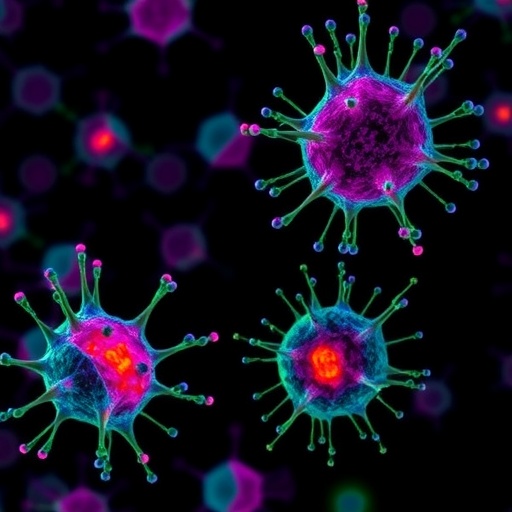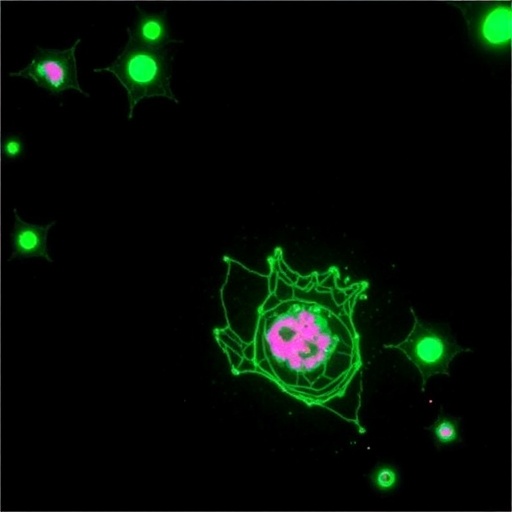In an exciting advancement at the intersection of traditional medicine and cutting-edge biomedical research, a team of scientists has unveiled critical insights into the anti-cancer potential of ginsenoside Rh4, a bioactive compound derived from ginseng, specifically targeting acute myeloid leukemia (AML) cells. This breakthrough study integrates network pharmacology, molecular docking, and experimental validation to elucidate the molecular mechanisms by which ginsenoside Rh4 exerts its therapeutic effects. Given AML’s aggressive progression and limited treatment options, this research shines new light on possible avenues for innovative and effective therapies rooted in natural product pharmacology.
Acute myeloid leukemia is a hematological malignancy characterized by the rapid proliferation of abnormal myeloid progenitor cells, leading to bone marrow failure and severe immunosuppression. Current therapeutic regimens involve high-intensity chemotherapy and hematopoietic stem cell transplantation, yet many patients face drug resistance and relapse, underscoring the urgent need for novel treatments. Ginsenoside Rh4, a lesser-studied constituent of Panax ginseng, has previously demonstrated diverse pharmacological activities including anti-inflammatory and anti-tumor effects, but its specific role and mechanism in combating AML remained unclear until now.
The researchers employed a sophisticated network pharmacology approach to map the intricate relationships between ginsenoside Rh4’s molecular targets and the biological pathways implicated in AML pathogenesis. By integrating data from public databases on drug-target interactions, gene expression profiles of AML, and disease-related signaling networks, they constructed a comprehensive interaction network revealing critical nodes that ginsenoside Rh4 could modulate. This systemic view is pivotal as it moves beyond single-target drug design towards understanding polypharmacology – how a single compound interacts with multiple protein targets to exert multidimensional therapeutic effects.
Expanding beyond computational predictions, molecular docking simulations provided atomic-level insights into how ginsenoside Rh4 physically binds with important protein targets implicated in AML. The team identified high-affinity docking poses between Rh4 and specific kinases and transcription factors known to regulate cell proliferation and apoptosis in leukemic cells. These simulations revealed significant hydrogen bonding and hydrophobic interactions stabilizing the Rh4-protein complexes, suggesting a robust inhibitory action on the oncogenic pathways that drive leukemia cell survival and multiplication.
The integration of experimental validation was a critical strength of this study. Utilizing human AML cell lines, the investigators confirmed that treatment with ginsenoside Rh4 significantly reduced cell viability in a dose-dependent manner. Mechanistic assays revealed that Rh4 treatment induced apoptosis—programmed cell death—in AML cells, while sparing healthy hematopoietic cells, indicating selective cytotoxicity. Additionally, Rh4 was shown to downregulate the expression of key survival proteins and transcriptional regulators identified in the network pharmacology analysis, corroborating the in silico findings.
Delving deeper, the research highlighted the role of ginsenoside Rh4 in modulating several hallmark signaling pathways of AML, including the PI3K-Akt, MAPK, and NF-κB pathways. These are well-known conduits that leukemia cells exploit to evade apoptosis and sustain uncontrolled proliferation. By interrupting these cascades, Rh4 effectively reprogrammed AML cells towards growth arrest and cell death. This multipronged mechanism is particularly promising for overcoming the redundancy and compensatory feedback loops that often thwart single-target therapies in cancer treatment.
An important aspect of the study was the validation of ginsenoside Rh4’s binding affinities through surface plasmon resonance and other biophysical techniques, lending empirical weight to the molecular docking predictions. The quantitative assessments of binding kinetics and affinities not only confirmed strong target engagement but also opened pathways for structure-activity relationship (SAR) optimization. This knowledge can drive future chemical modifications to enhance Rh4’s potency, stability, and bioavailability, key parameters for drug development pipelines.
The compelling synergy between computational network models and experimental data in this research exemplifies the future of drug discovery for complex diseases such as AML. By bridging in silico and in vitro modalities, this study moves beyond traditional trial-and-error approaches and rapid, cost-effective identification of promising drug candidates with validated mechanisms of action. Ginsenoside Rh4, therefore, emerges as a prototypical natural compound with multi-target capabilities that could be therapeutically leveraged for hematologic malignancies.
Moreover, given the historical use of ginseng in Asian traditional medicine, these results provide a scientific foundation for repurposing or integrating herbal compounds into mainstream oncology paradigms. The reduction of side effects linked with synthetic chemotherapy and the enhanced specificity of natural product-based drugs could revolutionize AML treatment landscapes, particularly for patients with relapsed or refractory disease who currently have limited options.
The researchers emphasized that while the findings are promising, further preclinical and clinical trials are necessary to fully understand the pharmacodynamics, pharmacokinetics, and safety profiles of ginsenoside Rh4 in humans. Dose optimization studies and combination experiments with existing AML therapies will be crucial to translating these laboratory insights into effective, patient-centered treatments. Nonetheless, the groundwork laid by this study offers an inspiring blueprint for harnessing natural bioactives through modern pharmacological strategies.
In conclusion, the fusion of traditional medicinal wisdom with the power of modern computational and experimental technologies has illuminated ginsenoside Rh4 as a potent, multi-target candidate against acute myeloid leukemia. This research not only enhances our molecular understanding of Rh4’s anti-cancer effects but also underscores the vast untapped potential of natural products in conquering challenging malignancies. As the scientific community eagerly anticipates further developments, this work epitomizes innovative, interdisciplinary approaches driving the future of cancer therapeutics.
Subject of Research: Acute Myeloid Leukemia and ginsenoside Rh4 mechanisms
Article Title: Network pharmacology, molecular docking, and experimental validation-based approach to explore the mechanism of action of ginsenoside Rh4 on acute myeloid leukemia cells
Article References:
Zhang, X., Sun, P., Liang, X. et al. Network pharmacology, molecular docking, and experimental validation-based approach to explore the mechanism of action of ginsenoside Rh4 on acute myeloid leukemia cells. Med Oncol 43, 8 (2026). https://doi.org/10.1007/s12032-025-03128-y
Image Credits: AI Generated
DOI: https://doi.org/10.1007/s12032-025-03128-y
Tags: acute myeloid leukemia treatmentanti-cancer properties of ginsengbioactive compounds in medicinedrug resistance in AMLginsenoside Rh4innovative cancer therapiesleukemia cell proliferationmolecular docking techniquesnatural product pharmacologynetwork pharmacology in cancertherapeutic mechanisms of ginsenosidestraditional medicine and modern research





